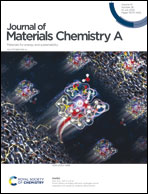Chromium-rich CrxIr1−xO2 wire-in-tube alloys for boosted water oxidation with long standing electrocatalytic activity†
Abstract
Chromium–iridium oxide (CrxIr1−xO2) alloys with a wire-in-tube morphology were primally prepared as highly efficient electrocatalysts for the oxygen evolution reaction (OER) via a simple electrospinning method. The synthetic processes with an optimized annealing temperature and a rate of calcination process were finely controlled to shape a distinct double-shell nanotube architecture. A low iridium-content oxide alloy (CrxIr1−xO2 with Cr : Ir atomic ratio of 62 : 38) derived from electrospinning and the post-calcination process was the first to reveal the remarkable OER performances in alkaline solution. Moreover, it maintained the performance throughout the long-term chronopotentiometry test at a constant current density of 10 mA cm−2 without any deterioration. In particular, density functional theory (DFT) calculations prove that the Cr-rich catalyst improves the binding of OOH species on the (110) facet of the CrxIr1−xO2 surface and lowers the Gibbs free energy barrier of the OER process with superior electrocatalytic activity based on the mechanistic inspection of the electrochemical processes.



 Please wait while we load your content...
Please wait while we load your content...